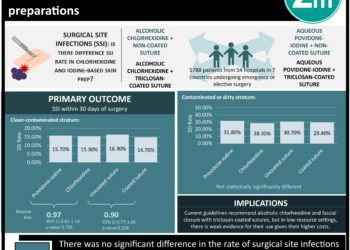Disproportionately higher mortality from gastrointestinal congenital anomalies among lower income countries
1. 30-day mortality from gastrointestinal congenital anomalies in low-income countries was 7-times higher than high-income countries.
2. Other mortality risk factors were identified, such as sepsis at presentation, a higher ASA score, lack of surgical safety checklist and unavailable parenteral nutrition when needed.
Evidence Rating Level: 2 (Good)
Study Rundown: Timely access to life-saving neonatal surgery is necessary for the survival of many children presenting with gastrointestinal congenital anomalies. This prospective cohort study of 74 different countries demonstrated the healthcare disparity between low-income, middle-income, and high-income countries. Healthcare data was collected from 3849 patients with gastrointestinal congenital abnormalities from 264 hospitals. Follow-up lasted 30 days after primary intervention or 30 days after admission if no intervention was given. The primary outcome was all-cause in-hospital mortality with secondary analysis of other risk factors. This study found a sharp increase in mortality between high- versus low-, and middle- versus low-income countries. Additional factors, such as higher American Society of Anesthesiologists (ASA) scores, sepsis at presentation, and lack of ventilation or parenteral nutrition when needed were associated with increased mortality. Limitations of this study include a smaller than representative number of patients from low-income countries (2% vs 9%). Nevertheless, this is a large-scale study that demonstrates the inequality of healthcare access across the globe.
Click to read the study in the Lancet
Click to read an accompanying editorial in the Lancet
In-Depth [prospective cohort]: The Global PaedSurg Research Collaboration collected data from 3849 patients in 74 different countries with gastrointestinal congenital anomalies. Included abnormalities were as follows: esophageal atresia, diaphragmatic hernia, intestinal atresia, gastroschisis, exomphalos, anorectal malformation, and Hirschsprung’s disease. Of the participants, 896 were from high-income countries, 2860 were from middle-income countries and 93 were from low-income countries. 90% of the patients were neonates with a median age at presentation of 72 hours, 24 hours, and 3 hours in the low-, middle-, and high-income countries, respectively. 58.0% of patients were male and all were younger than 16 years old. The primary outcome of all-cause in-hospital mortality was significantly different (p<0.0001) between all income groups. More specifically, mortality rates were highest in the low-income group (39.8%), followed by the middle- (20.4%) and high-income (5.6%) groups. The relative risk (RR) of mortality between low versus high-income was 2.78 (p<0.0001). Secondary outcomes included a risk analysis of all patients. Other factors, such as sepsis at presentation, higher ASA score, no use of surgical safety checklist, unavailable ventilation or parenteral nutrition were also associated with a higher mortality risk. On the contrary, a peripherally inserted central catheter (RR 0.65), percutaneous central line (RR 0.69), and parenteral nutrition (RR 0.61) were associated with a lower mortality risk.
Image: PD
©2021 2 Minute Medicine, Inc. All rights reserved. No works may be reproduced without expressed written consent from 2 Minute Medicine, Inc. Inquire about licensing here. No article should be construed as medical advice and is not intended as such by the authors or by 2 Minute Medicine, Inc.







